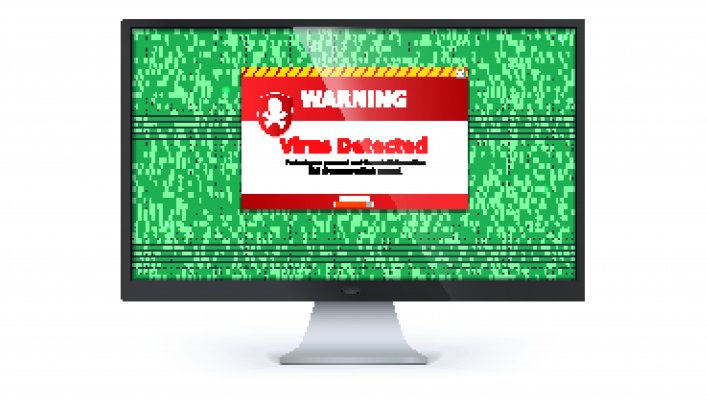Almost all computer users regularly use the internet for different purposes. This can be for communication, gaming, business, and more. In the internet, people usually either upload or download data.
Because this is a common activity for most, people online with intentions for stealing and scamming take advantage of it. They upload files in the internet that can be harmful for its users. The harm it can do for the user ranges from corrupting their files, deleting them, or even tracking their activities and sharing it without the user’s knowledge.
A malware is defined as any software that was made to harm the computer. As mentioned before, this comes in different forms, all of which is a big nuisance to the user. Because of its harmful nature, it is usually deceptively blended with seemingly safe content as to be downloaded accidentally by users.
There are a lot of types of malware made that differ in terms of damage made to the computer, creator, and more.
- Viruses – This is the most popular and common type of malware. Similar to its real-life namesake, these malicious files are capable of self-replicating which makes it hard to delete completely from the computer. Often, these files attach itself to other safe applications. Once users activate these applications, the viruses are enabled and will start replicating itself. The damage a user can suffer from these files include corrupted files, deleted files, or even a completely unusable computer (which will need a complete reformat). These are usually detectable with antivirus applications which will quarantine or delete these from the system.
- Ransomware – As the name implies, this malware holds the user’s files for ransom until they pay for a certain amount. Ransomware can either completely or partially hold all access of the user’s PC. The creator of the file will demand payment via cryptocurrency for an encryption key which can be used to be able to use the PC again. However, there is no guarantee that they will fulfill their promise which makes this as an especially dangerous malware. This is one of the most harmful types of malware as it is known to devastate the computers of hospitals, offices, and even a city government system.
- Worms – These are malware that behave similarly to viruses except that they do not need an action from the user in order to work. It simply needs a security vulnerability from the user or a gateway (flash drives, disks). It can also be accidentally downloaded in the computer by opening a risky e-mail. These files can even infiltrate networks and spread itself through a whole office or school. Worms can steal sensitive data from the user or even commit a ransomware attack. It can also do repetitive actions or spam in the computer.
- Trojans – These are malware that present itself as safe and genuine applications but is actually harmful for the computer. They have been around longer than viruses as most hackers prefer this type of malware because it can easily deceive some users to open it. The most common form of trojans are applications which mask itself as antivirus or anti-malware applications that notify the users that there is something wrong with their PC. Once the application is opened, the hacker gains access to the computer.
- Hybrid malware – Most of the malware that exist nowadays are a combination of two common ones such as a trojan malware that acts as a worm. This is more common nowadays that people are more cautious about opening unsafe websites and downloading illegal content. Because it is a mixture of two, it might be harder for antiviruses to remove this from the computer.
- Rootkits – This malware is a type of file that gains administrative control over a user’s computer. This means that it can do activities on your computer without your consent. This often results to your personal info being hacked. These files are usually found inside hypervisors, applications, and kernels. They can be spread by hackers through phishing and by mixing it with illegal files online. This type of malware usually comes with other malware such as worms or keyloggers.
- Keyloggers – This is a type of application that can be used by a hacker to keep track of user’s computer activities. It is important to take note, though, that some keyloggers can be legitimately used in the office as to monitor the activities of employees. However, they can also be used by hackers to keep track of everything someone types in the computer which often leads to the latter’s private data to being stolen. This might include their social media passwords, credit information, and more. This is often the reason for hacked accounts.
- Bots – Any application that can repeatedly do an automated task or command by a user can be classified as a bot. This is often used for search engines, legal purposes, and more. However, they can be used maliciously whenever it is intended to perform an overwhelming number of commands against a user to make them unable to use their computer. It may also be used to steal sensitive data and to disrupt business activities.
- Adware – These are trackers put by advertisers into users’ computers. Without the latter’s knowledge, their activities are tracked online to see their brand preferences for the advertisers to be able to target them with personalized ads. While these apps do not corrupt or delete data, it is still malware as it invades users’ personal privacy and sells them online. Aside from this, some is even capable of changing the default search engine of a computer or constantly flood them with advertisements.
- Mobile malware – As smartphones increase in terms of storage and as casual users continue to pour more time in to using them, they have now been one of the priorities for hackers. This is because they are usually easier to hack compared to computers. Mobile phones also usually contain lots of important information such as banking details, social media passwords, and more. Most of the malware for phones comes in the form of bloatware, adware, and more. The common target phones are jailbroken ones as these usually does not have the same software security that comes with a new phone.
As mentioned above, malware comes in a variety of forms, each with their own ways of infiltrating a computer’s or a person’s defenses. They are usually made by hackers who would like to have an influence on the internet or those who sell users’ personal information on the black market.
The damage incurred from malware ranges depending on the type of malware.
For starters, the most common and the least damaging are those that only that create minor inconveniences for the user. Examples are those that turn files into shortcuts, those that spam advertisements, and the likes.
However, malware can also be used for serious crimes that can affect a user’s personal data or cause financial damage. An example is whenever a user’s social media is hacked to leak personal photos and messages. Hackers can also take a user’s banking credentials including their bank numbers, online banking passwords, and the likes. This type of attacks will need legal action from the user’s side.
With all this malware, you may be wondering how vulnerable you are to an attack. After all, most of the people nowadays have some form of accessing the internet either through mobile, gadget, or through the computer. It is also almost impossible to avoid downloading anything in the internet at all.
In terms of vulnerability, there are a lot of determining factors. This includes the following:
- Websites visited – Users who tend to visit only major websites that have reliable security such as known social media sites or news sites are less likely to have malware as the defenses of these websites are hard to penetrate. Any harmful files that may be downloaded here are usually hard to find. However, those who tend to visit websites sharing illegal content such as torrent files and pornography are vulnerable to security attacks especially if they easily download files from these.
- Amount of sensitive data stored – Users that does a lot of mobile banking and information sharing online are more vulnerable. This is because a keylogger may see all the data that a user types, including their passwords and security questions. This is why most banking websites nowadays requires a mobile code before allowing a user to enter their website (aside from typing their password).
- External devices – Computers which commonly open USBs and hard drives are prone to receiving malware. This is especially true if most of these come from strangers (a common scenario inside schools and computer cafes). This is because some users may not notice that their external hard drive contains malware which will then infect other files within the PC.
The damage that users can suffer from malware can range from simply being a nuisance up to ending with corrupted files, stolen privacy, and an unusable computer.
There are a lot of ways for users to protect themselves from malware. This includes the following.
- Installing an anti-malware application – This is the most common way for users to protect themselves. These apps are built towards adding protection for files that are installed in the hard drive. They can also serve as protection against harmful files that are downloaded online. These applications does a full scan of all installed files in the PC, gathers all malware, and quarantines them from the system. Users can then choose to either restore, quarantine, or delete these files. Aside from this, most of these apps also come with system optimizing features to improve PC performance.
While this is a common choice, users should be wary of applications that pose as anti-malware but is in fact dangerous for the computer. It is good for a user to first read reviews about an application to ensure that it is safe to be installed.
- Avoiding unsafe websites – Most malware can be accidentally downloaded by users whenever visiting unsafe websites. These are usually websites with illegal content. It is also better for users to avoid downloading from any websites unless they are fully sure of the application’s trustworthiness. Most of the malware that can be downloaded from unsafe websites are trojans and worms.
- Being wary of e-mails – Although this more uncommon nowadays that e-mails have more security measures to avoid spam and malware, users should still be wary of opening e-mails that do not come from a trusted source. This is because viruses can easily be hidden within e-mails which is the easiest way for it to infect a computer.
- Enable your firewall – The firewall is a digital protection that you can use to protect the computer’s private network. Any unauthorized access will be blocked by this. This is a feature that is built within PCs and Macs. However, some may choose to disable this for gaming reasons which is highly discouraged.
- Install a pop-up blocker – Pop-ups are advertisements that open another tab or another window of the internet browser you are using. These are usually accidentally clicked by users because they appear suddenly. Some of these may install adware and viruses within your PC.
- Getting identity security – Some malware are built to specifically steal credential and personal information from the user. These information are usually sold in black markets in the dark web. In the worst cases, users may suffer from identity theft or financial damage. Identity security services can be used to constantly keep track of a person’s credit scores, banking transactions, and more. Some may also come with identity theft insurance services that gives up to $1,000,000 for protection.





